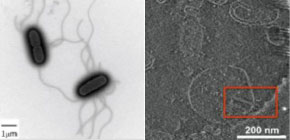
Successful in vitro reconstitution of type III secretion system of bacteria
Will be applied to screening of drugs that eliminate only virulence
A group of researchers at Osaka University achieved in vitro reconstitution of the flagellar type III secretion system (T3SS) of bacteria, reproducing protein transport via the system and flagellar hook formation, a world first.
Many bacteria move in water and the intestines using flagella, protein fibrilliform appendages, like a screw. Because flagella are formed outside of the cell, it is necessary to export flagellar proteins outside the cell. The T3SS plays a role in exporting these proteins.
The T3SS is an appendage composed of hundreds of protein molecules and is present in both the flagella and the injectisome, a needle-like appendage used by infectious bacteria to deliver proteins to their host. Pathogenic bacteria swim to their target/host cells using their flagella, injecting pathogenic proteins to the host cells via injectisome, which causes infection. If the means of transport and infection are derived from pathogenic bacteria, it will become possible to make pathogenic cells harmless. Thus, it is anticipated that new drugs to kill only virulence by targeting T3SS will be developed; however, no one has succeeded.
The researchers developed an in vitro flagellar T3SS protein transport assay system using an inverted cytoplasmic membrane vesicle (IMV). For in vitro reconstitution of protein transport by T3SS, IMVs purified membrane complex systems without damaging T3SS, succeeding in in vitro protein transport into vesicles.
The researchers confirmed that a flagellar hook was formed in a vesicle by externally adding proteins to the IMV solution, demonstrating that T3SS in the IMVs preserved the protein export activity. In addition, they clarified that proton motive force (PMF) or ATP hydrolysis was enough to facilitate transport and that even ATP hydrolysis alone was able to drive flagellar protein export without PMF.
Currently, the emergence of multidrug-resistant bacteria due to overprescribing of antibiotics has become a societal issue, so the development of treatment methods to serve as substitutes for antibiotics are highly sought after. One of the targets for the development of drugs for treating bacterial infection is T3SS. Once T3SS is inactivated, it will become possible to eliminate only virulence from pathogenic bacteria. This method doesn’t destroy disease causing bacteria, so there is no danger of producing drug-resistant bacteria and damaging intestinal flora such as beneficial bacteria. In addition, because the T3SS is a kind of bacterial inherent organ, it may cause fewer side effects. This group’s research results will contribute to society as new technology for controlling bacterial infections.
Figure 1
Figure 2
Figure 3
Figure 4
Figure 5
The article, "In vitro reconstitution of functional type III protein export and insights into flagellar assembly" was published in mBio , https://doi.org/ 10.1128/mBio.00988-18
Related link
